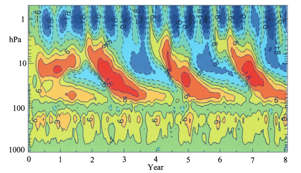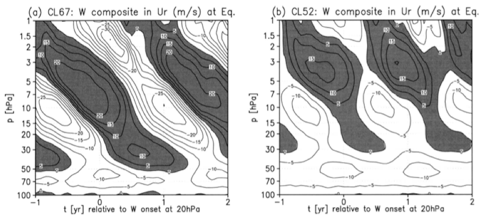Motivation for QBOi
”The prevailing winds in the atmosphere near the equator above about 17 km are known to undergo a slightly irregular oscillation from strong westerlies to strong easterlies roughly every other year. This Quasi-biennial Oscillation (QBO) has been observed to dominate the winds in this region of the atmosphere for at least the last 6 decades and is characterized by a downward propagation of the westerly and easterly jets that form. This video allows a 3D vizualization of the behavior of the QBO jets. Specifically what is shown are regions of strong westerlies/easterlies outlined by the red/blue surfaces. The long term mean seasonal cycle are subtracted from the data and surfaces are plotted only equatorward of 30 degrees. The height range plotted is about 17-36 km. Results are shown for 1980-2000.”
Observations
“Although several GCMs have produced simulations of the QBO, there is no simple set of criteria that guarantees a successful simulation.”
Following the original study of Takahashi (1996), only a small number of models have successfully captured realistic tropical stratosphere variability. For example, of the CCMs participating in the Chemistry-Climate Model Validation Activity Phase 2, only two reported an internally generated QBO, 7 chose nudging toward observations, while the remainder had no realistic QBO variability. Furthermore, in a recent study by Charlton-Perez el al., (2013) who compared 27 high-top and low-top models from the Coupled Model Intercomparison Project - Phase 5 (CMIP5), only 3 models captured a QBO.
In a study exploring the effects of future climate change on tropical stratosphere variability, using the MIROC AGCM, Kawatani et al. (2011) reported a longer period QBO toward the end of the 21st Century. This result was consistent with an increase in tropical upwelling following a general increase in strength of the Brewer-Dobson circulation. In contrast, under a future scenario (RCP8.5), the Met Office climate model HadGEM2-CCS has showed a decrease in the period of the QBO. The origin of these differences are not well understood, but is most likely linked to fundamental differences in the representation of processes driving the QBO in each model.

A dynamical theory for the QBO has been around since the late 1960s. Lindzen and Holton (1968) and Holton and Lindzen (1972) used a simple model of vertically propagating gravity waves, and their mutual interaction with the background wind, to dynamically describe the low frequency variability (i.e. the QBO) observed in the tropical stratosphere.

Numerous studies have explored the characteristics and sensitivities of the QBO within individual global climate models (GCMs), however little has been done comparing across GCMs. Generally, these studies have examined those changes in dynamical and physical (parameterised) processes thought important for producing realistic tropical stratosphere variability.
Giorgetta et al. (2006) examined the effects of resolution (horizontal and vertical) and parameterised gravity wave (GW) forcing on the QBO, within MAECHAM5. They reported a number of sensitivities, including: the period of the QBO to be inversely related to changes in parameterised/resolved GW forcing, and the amplitude of the eastward QBO phase to be dependent on vertical resolution. Furthermore, it was concluded that a spontaneous QBO required vertical resolution finer than 1km.


Modelling studies overview
CMIP5
The first reported GCM study showing QBO-like vacillations in the equatorial stratosphere (Takahashi et al., 1996)
Sensitivity of QBO morphology to changes in vertical resolution (Giorgetta et al., 2006)
Momentum budget of tropical stratosphere variabiity the MIROC AGCM (Kawatani et al., 2011)
QBO period in MIROC AGCM increases under future global warming, (Kawatani et al., 2011)
Outstanding Challenges - QBOi
Since the original mechanistic study by Lindzen and Holton (1968) and the early modeling advances seen during 1996-2000, little progress has been made reproducing a robust QBO across GCMs.
The objective of QBOi is to improve the fidelity of tropical stratosphere variability in present-day GCMs. This will be achieved by first (1) evaluating past and present-day modelled QBO variability by way of a Questionnaire, and (2) by soliciting the participation of modelling groups to design numerical experiments to evaluate the sensitivity dependencies of tropical stratosphere variability in current GCMs. Examples of these dependencies include details such as vertical resolution, wave parameterisations etc.
Our intention is that this will provide a ‘recipe book’ for simulating a reliable QBO, informing models contributing to CMIP6 and for NWP groups.
QBOi is focussed on modelling studies, but will benefit from other projects, notably within SPARC, such as: Gravity Waves (for constraining estimates of parameters within GCMs) and the Data Assimilation Working Group project S-RIP: SPARC Reanalysis/Analysis Intercomparison Project (for tropical wave climatologies). The output from QBOi will also be beneficial to programmes such as the Working Group for Numerical Experimentation (WGNE), CCMI (tracer transport) and DYNVAR (high-latitude impacts, e.g. Holton-Tan relationships and stratosphere-troposphere coupling).
The tangible deliverables for the project include peer reviewed papers from individual groups